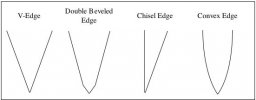Get out your knife and look at it. You will notice most of the blade is ground at an angle toward the edge.
What does it mean if something is "ground"?
It's thick at the spine and a little of the blade near the spine is flat but then it angles down and gets thinner as it gets nearer the edge. That is the primary grind. That was ground by the manufacturer and you don't want to change that.
Okay I understand what a primary grind is now, thanks

Then there's the edge grind, at a steeper angle right at the edge. That is where you will grind to sharpen the knife.
The bolded "grind" is used in a verb form from what I understand. What does it mean to grind something? It can't mean to "sharpen" since you mention sharpen in the latter part of the sentence.
As for the first sentence in the quote, I just noticed now as you mentioned it, I see how it is angled different right at the edge. In the case of my Nighthawk, it has a silvery coloured metal all around the edge grind. But the rest of the knife is black.
Did you even click on the link I posted? This has got to be a joke. Seriously,
Buy a new knife and throw the old one out when it gets dull. I honestly cannot believe this...
I didn't click on the link, my apologies.
TorzJohnson, I understand that concept now that Cougar has explained that there's not one angle on the blade.
As for the
sharpeners linked, I don't understand how's it's different from the Edge Pro. Other than the fact that it's many times cheaper. All I want is a product that can give my knife the
angle of my choice and be able to
keep that angle every time I sharpen. Will this product do that?
Oh and now that I know what an edge grind and a primary grind are, I can understand the diagrams posted before. Thank you Cougar, for being the only one I could understand



